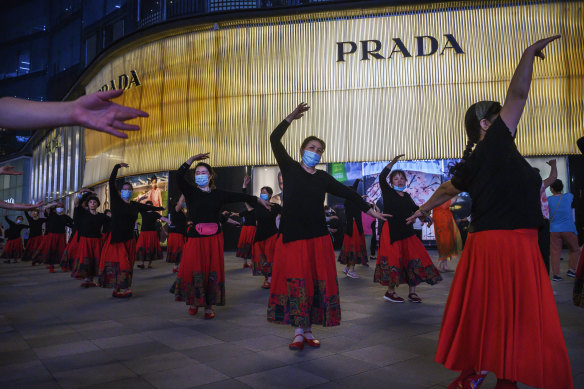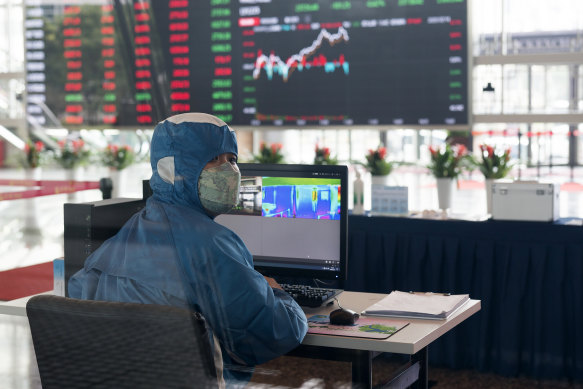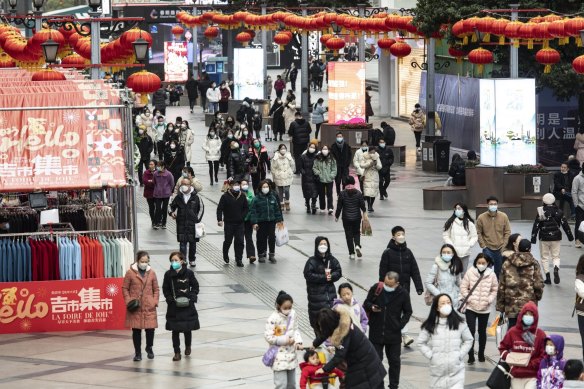
Loading
Burberry, Gucci and Estée Lauder are just some of the luxury names whose profits have suffered because of faltering Chinese demand.
But the shift away from Western brands only scratches the surface of the changes taking hold in the world’s second-largest economy. Growth is slowing. Money is tight. And trade tensions are flaring.
China grew 4.7 per cent in the second quarter of 2024, slower than the 5.1 per cent predicted by economists as nervous foreign investors pulled a record £12 billion ($23.4 billion) out of the country over the same period, in a blow to President Xi Jinping.
‘The four Ds’
Some fear the world’s factory is now in overdrive as shrinking profits force producers to ramp up output just to get enough cash to service their debts.
Zongyuan Zoe Liu, a senior fellow at the Council on Foreign Relations, believes China is at risk of being sucked into a “doom loop” of falling prices, factory closures and job losses that will leave it facing a Japanese-style lost decade.
She believes China’s problems have long been rooted in the “four Ds” – debt, demand, demographics and decoupling from the rest of the world.
Liu highlights government data that shows a third of Chinese vehicle manufacturers were unprofitable in May. Cars are getting cheaper quickly: the average electric vehicle produced by Chinese giant BYD now costs 20 per cent less than a year ago.
Prices across the economy were shrinking at the end of 2023 and have only just started rising again, climbing 0.5 per cent in July from a year ago.
Most economists would describe a temporary fall in prices as an effective tax cut. However, Liu points out that the drop has been accompanied by weak incomes.
“Household income growth has basically stagnated,” she says.

China’s consumers are starting to turn away from luxury brands. Credit: Getty
“Combine that with the property market crash, and the fact that most people’s wealth is tied up in their house, and it’s clear this has not been good for motivating consumption.”
Tina Wu, a 27 year-old PhD student living in Beijing, says the post-pandemic jobs landscape is tough.
“It’s not very easy for young people to find well-paying jobs due to the impact of the pandemic,” she says. “Many companies have reduced salaries.”
Wu, who used to work as a designer in a government architecture firm before returning to university, remains upbeat about the future.
“I’m optimistic that in three to five years, the job market will recover and be thriving again,” she says.
Not everybody is as upbeat as Wu.
Ben Cavender, managing director at China Market Research Group says it is clear that Chinese consumers have been tightening their belts.
Loading
“Consumer confidence is low right now, and if anything getting lower,” says Cavender, who is based in Pudong, near Shanghai.
“There is a lot of dismay that not much has been done by the government to improve job prospects or salaries, and people are still very worried about future job cuts and a lack of rebound in the housing market.
“This is especially true for younger consumers. I think the feeling on the ground in Shanghai is that the economy is slow, I know very few business owners who are happy right now.”
Cavender adds that many are keeping their options open. “The wealthier Chinese that I know are also still quite intent on getting their kids out of the country for education and green card purposes just as a hedge.
“The sense is that it will be a couple of years before things truly get better.”
The Guochao trend
They called it the Guochao trend. Literally translated as “national wave”, China’s Gen Z have been shifting their purchases towards local brands that reflect national pride.
“Chinese brands took advantage of Covid to become much better at brand positioning and marketing, and can be as competitive or more competitive than foreign brands now in a lot of categories,” says Cavender.
However, this switch also masks a new frugality. Retail sales growth has struggled, and is now close to its lowest level since the country emerged from lockdowns.

Foreign investors pulled a record £12 billion ($23.4 billion) out of the country.Credit: AP
“Trading down is still very much a topic at hand,” says Cavender.
“The luxury space is a good example of that. Consumers are tending to either allocate their spending up to the most premium brands or are trading down towards premium athleisure. This is partly why we see brands like Gucci struggling so much at the moment.”
Gen Z youngsters such as Tina Wu are keen to make up for lost time.
“Life in Beijing has returned to how it was before the pandemic – busy, crowded, and full of energy,” she says.
Loading
“I’m actually spending more money now than during the pandemic. I’m going out more for shopping, dining and social activities, which has increased my expenses. During the pandemic, I mostly stayed at home, so my spending was much lower.”
While Cavender says the mood around him is more downbeat, life goes on.
“China is still China,” he says.
“So very convenient daily life, lots of technology, safe and getting cleaner by the day.”
Shanghai’s streets are much quieter than they used to be. Not because of the scars of lockdown, but simply because the diesel and petrol vehicles that used to whizz around the city have been replaced by the quiet whirr of thousands of electric cars and scooters.
Andy Xie, former Morgan Stanley chief Asia economist, says life for most people is back to normal.
However, he says many who used to work in China’s $US3 trillion ($4.4 trillion) shadow banking industry are hurting. “The era of cheap money has gone.”
The industry, which has fuelled the explosive credit growth in recent years, has enabled an easier flow of credit to small and medium enterprises.
Much of this money was invested in the property market, which is now on its knees. Regulators continue their crackdown on the sector.
“All these people who worked in finance wanted to create the types of profits that would allow them to live like a banker from Goldman Sachs,” Xie says.
“But what we’re seeing in China is the froth in the system with this property bubble really dissipating.”
Xie says the speculators in China have been forced to adjust their lifestyles the most.
“The economy going forward will be very different,” he says.
“The easy money is gone. And without easy money, you’re not going to go out and buy a Ferrari.”
Beyond China
International tensions are another worry. Donald Trump has already vowed to escalate its trade war with China if he returns to the White House next year, while Kamala Harris said this week that as president she would ensure “America, not China, wins the competition for the 21st century”.
Lun, who is currently in the US on a business trip, says many Chinese bosses remain worried about what the future holds.
“I see companies that used to export to Europe and America shifting their focus to domestic sales and export to other developing countries,” he says.
“The concerns about future trade wars have made lots of Western buyers wary, adding to the problems of softening sales in those traditional markets. The buyers I deal with worry about tariffs, but that’s out of our control.”
However, he also wants to keep his options open.
“We are looking to expand and grow outside of traditional Western markets,” Lun says.
“We were looking at the Middle East, also India. But demographically [they are] very different places.”
Fears about overcapacity are creating more trade tensions, with many countries including the UK worried about being flooded with cheap cars in order to meet net zero targets.
Some nations have already sought to block this. The US has announced a 100 per cent tariff on Chinese electric vehicles, as well as a 25 per cent tariff on batteries, parts and critical minerals in a bid to keep them out.
Xie believes this is the start of a bigger decoupling that will see the US and other Western nations pay higher prices for goods going forward as China, which is becoming less reliant on the West for technology to drive development, looks to do more business in Asia, Africa and elsewhere.

China’s citizens are turning away from Western brands to focus on home-grown products. Credit: Bloomberg
He says the US in particular has not faced up to the fact that the rest of the world doesn’t have to play by its rules anymore.
“Anglo Saxons are good at two things: talking and fighting,” he says.
“They are not very good at working. So they usually use their skills to talk about fighting in order to get other people to work for them. The past 500 years have been like that.
“But in terms of getting things done, they can never win against the Chinese. So they are basically deluding themselves. The issue is that they don’t want to accept that China is going to be the largest economy.”
But the evidence also suggests that China remains cautious about moving too close to countries such as Russia as it worries about the potential impact of secondary sanctions.
While Vladimir Putin’s state visit to China this year was intended to demonstrate their “no limits” friendship, one business owner operating in eastern China says many factories have stopped doing business with Russian intermediaries after Chinese banks began refusing to process payments.
“Since the invasion of Ukraine [in 2022], there’s been a lot of Chinese goods exported to Russia through intermediaries facilitating these transactions mostly via the Middle East and north east China,” they say.
“Since the beginning of this year, many of those factories stopped doing business with intermediaries for Russia. Getting paid for the goods has become a big issue because the Chinese banks won’t process payments any more if they suspect it’s related to Russia.”
The big question surrounding China going forward is growth.
The International Monetary Fund believes the rate of economic expansion is likely to slow to just over 3 per cent by the end of the decade because of weak domestic demand.
“I don’t think the Chinese problem can be solved anytime soon, even if the government is willing to enact all the reforms needed to boost consumption and separate government from industry. It will take at least a decade to reshape institutions,” says Liu.
For now, growth and its drivers are likely to remain on shaky foundations.
“The question is not just how fast the economy is growing, but the drivers of that growth,” Liu says.
Loading
“The Chinese economy is almost $US18 trillion now. So 3 per cent on top of that in absolute terms is still a lot of growth.
“But the problems arise when in order to generate this amount of growth, there is a cost in terms of debt, in terms of deeper structural imbalances, and the sacrifices made in terms of geopolitics. So the question is not how much China grows in the coming years, but at what cost?”
The new trend towards frugality in the world’s second largest economy risks being only a foretaste of what is to come.
Telegraph, London









 Add Category
Add Category